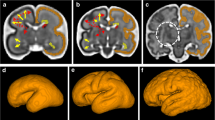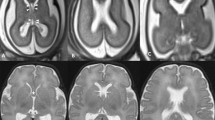Abstract
In the previous article, we considered the normal appearances of the midline stuctures of the brain as they appear on high-resolution magnetic resonance imaging. In this article, we discuss the effects of failed commissuration on the midline structures. We highlight some of the misconceptions of this process that may lead to misdiagnosis of agenesis of the corpus callosum in utero.







Similar content being viewed by others
References
Taylor M, David AS (2005) Agenesis of the corpus callosum: a United Kingdom series of 56 cases. J Neurol Neurosurg Psychiatry 25(13):1181–1187
Fratelli N, Papageorghiou AT, Prefumo F, Homfray T, Thilaganathan B (2007) Outcome of prenatally diagnosed agenesis of the corpus callosum. Prenat Diagn 27:512–517. doi:10.1002/pd.1719
Rapp B, Perrotin F, Marret H, Sembely-Taveau C, Lansac J, Body G (2002) Value of fetal cerebral MRI for the prenatal diagnosis and prognosis of corpus callosum agenesis. J Gynecol Obstet Biol Reprod (Paris) 2(1):173–182
Whitby EH, Paley MNJ, Sprigg A, Rutter S, Davies NP, Wilkinson ID, Griffiths PD (2004) Outcome of 100 singleton pregnancies with suspected brain abnormalities diagnosed on ultrasound and investigated by in utero MR imaging. Br J Obs Gynae 111:784–792
Glenn OA, Barkovich AJ (2006) MRI of the fetal brain and spine: an increasingly important tool in prenatal diagnosis (part 2). AJNR Am J Neuroradiol 27(9):1807–1814
Griffiths PD, Batty R, Reeves M, Connolly DAJ (2009) Imaging the corpus callosum, septum pellucidum and fornix in children: normal anatomy and variations of normality. Neuroradiology (in press).
Barkovich AJ (1995) Congenital malformations of the brain and skull. In: Barkovich AJ (ed) Pediatric neuroimaging 2nd edition. Raven, New York, pp 177–275
Rakic P, Yakovlev PI (1968) Development of the corpus callosum and cavum septi in man. J Comp Neurol 32:45–72. doi:10.1002/cne.901320103
Raybaud C (2003) Classification of commissural disorders (callosal agenesis and related disorders). Riv Neuroradiologia 16(2):179–182
Barkovich AJ (1990) Apparent atypical callosal dysgenesis. AJNR Am J Neuroradiol 11:333–340
Sadler TW (1990) Central Nervous System Chapter 20. In: Sadler TW (ed) Langman's Medical Embryology 6th edition. Williams and Wilkins, Baltimore, p 376
Conflict of interest statement
We declare that we have no conflict of interest.
Author information
Authors and Affiliations
Corresponding author
Rights and permissions
About this article
Cite this article
Griffiths, P.D., Batty, R., Connolly, D.A.J. et al. Effects of failed commissuration on the septum pellucidum and fornix: implications for fetal imaging. Neuroradiology 51, 347–356 (2009). https://doi.org/10.1007/s00234-009-0507-x
Received:
Accepted:
Published:
Issue Date:
DOI: https://doi.org/10.1007/s00234-009-0507-x




